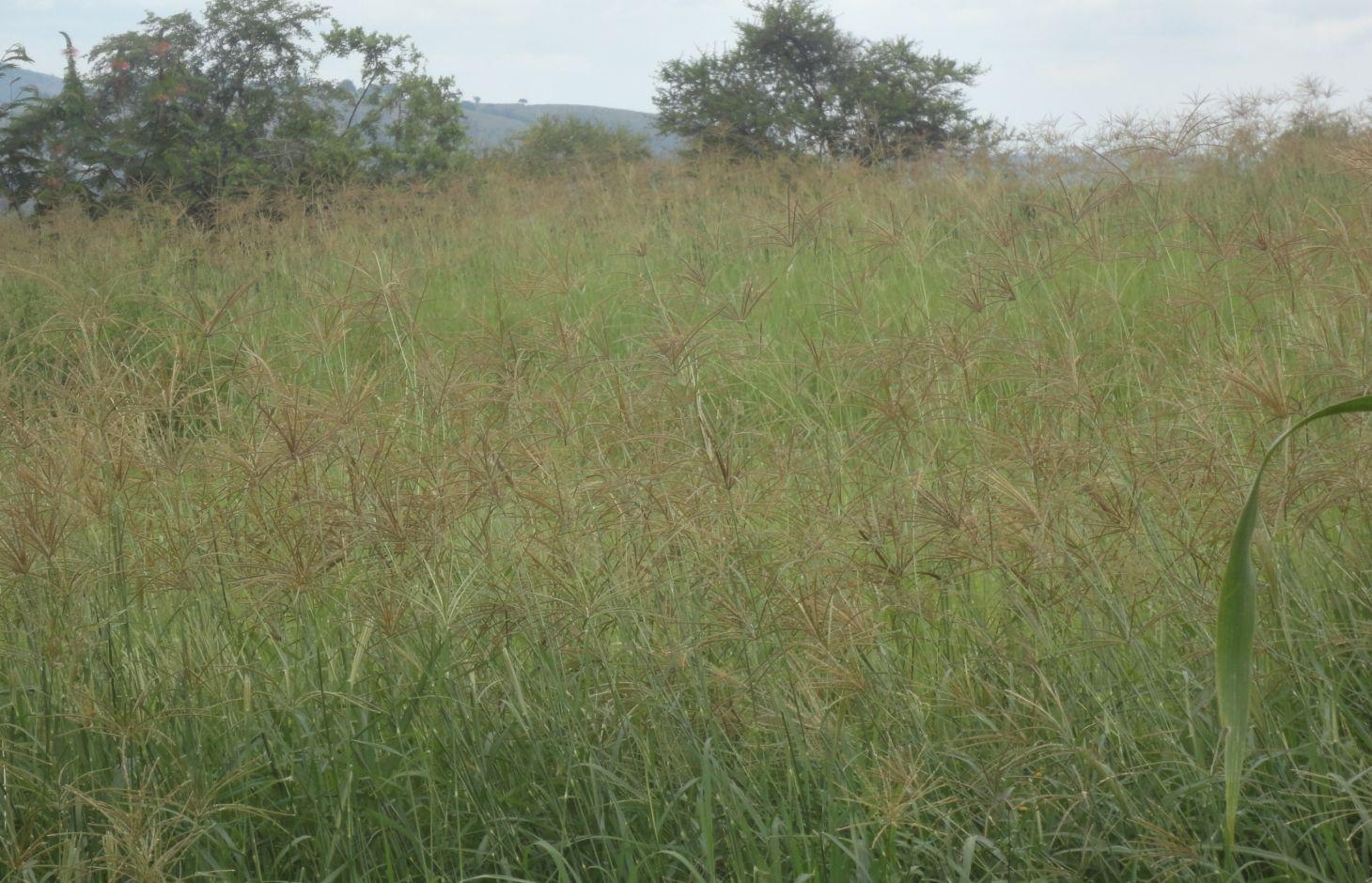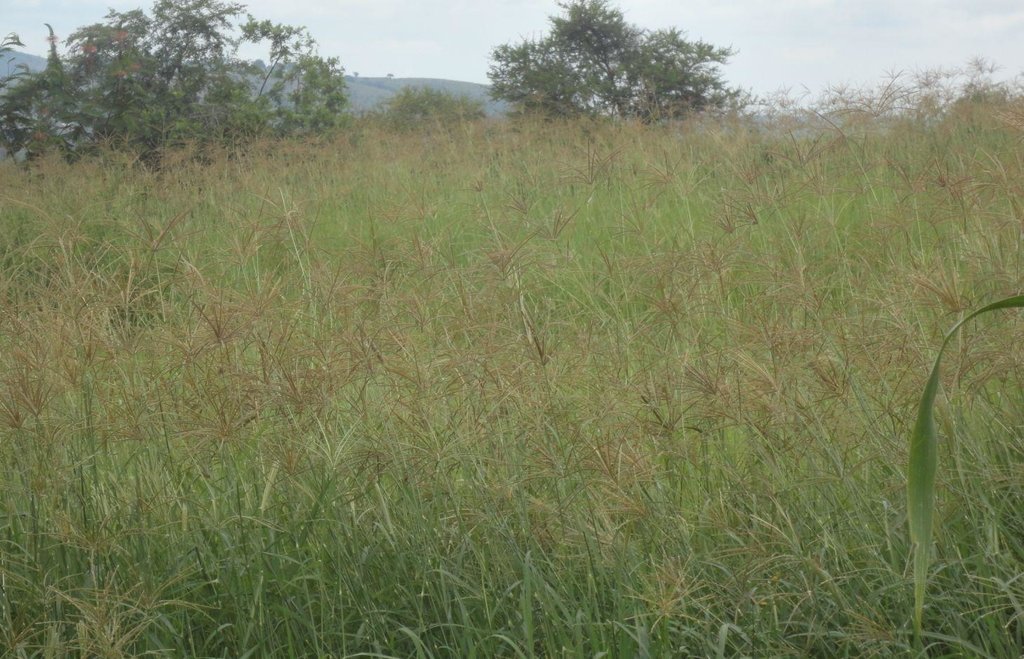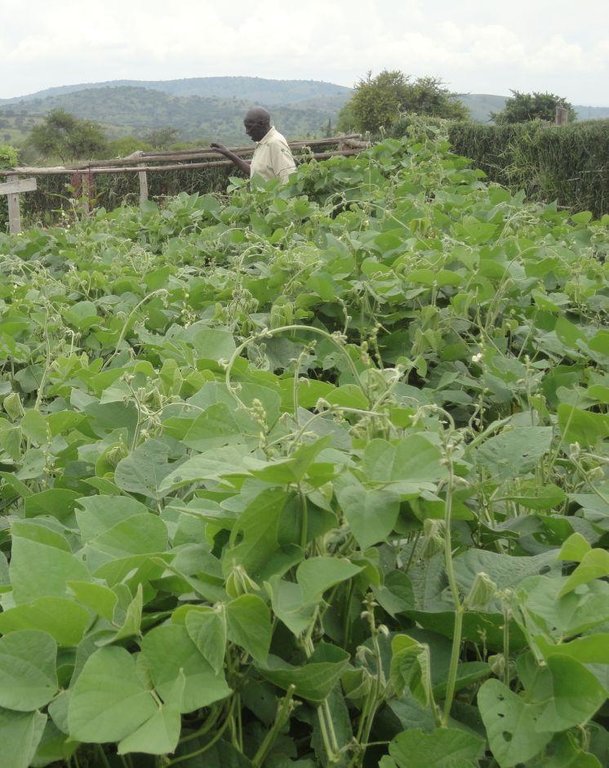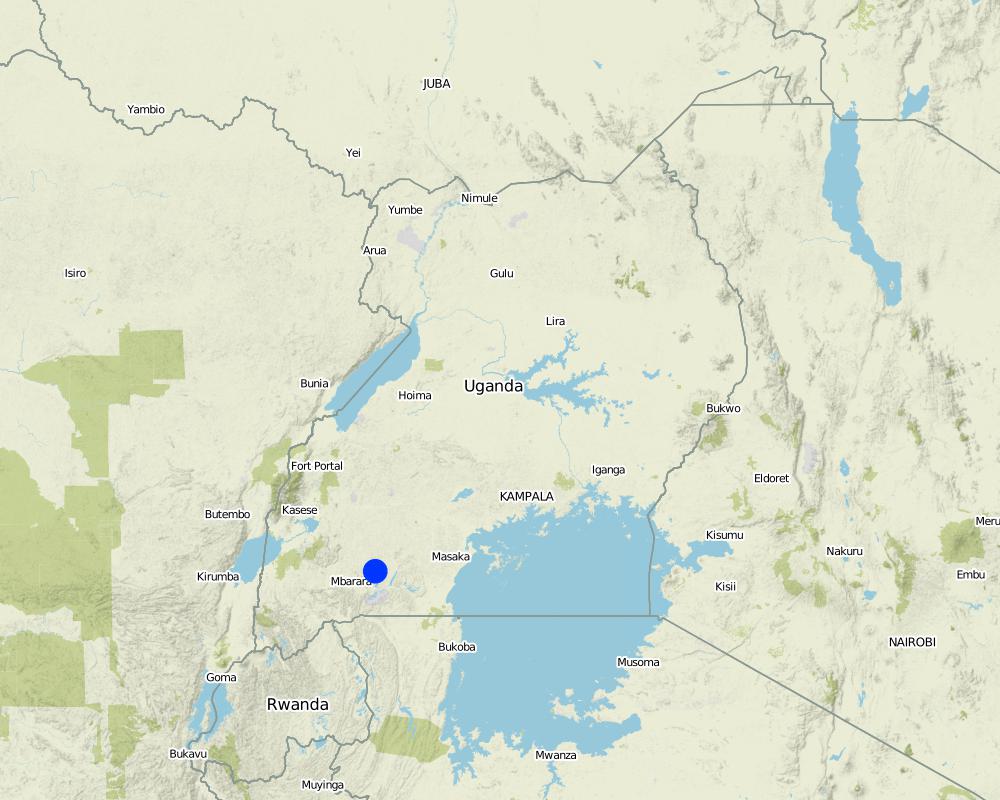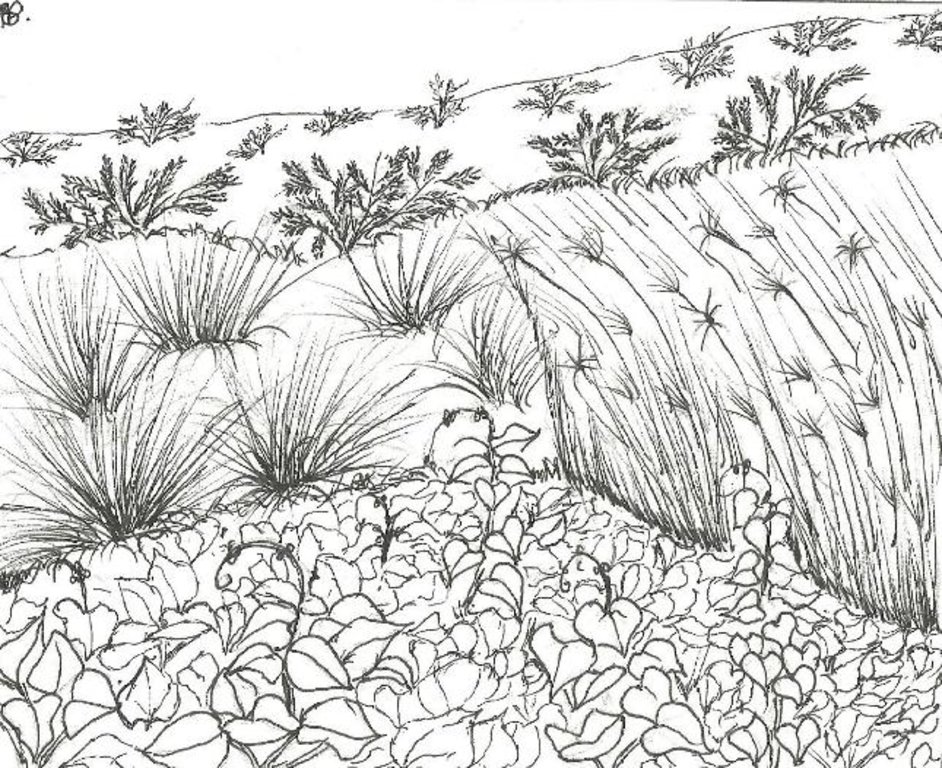Improved fodder production on degraded pastureland [Uganda]
- Creation:
- Update:
- Compiler: Wilson Bamwerinde
- Editor: –
- Reviewers: Fabian Ottiger, Alexandra Gavilano
Okubyara Obunyatsi (Runyankore)
technologies_1588 - Uganda
View sections
Expand all Collapse all1. General information
1.2 Contact details of resource persons and institutions involved in the assessment and documentation of the Technology
SLM specialist:
SLM specialist:
Name of project which facilitated the documentation/ evaluation of the Technology (if relevant)
The Transboundary Agro-ecosystem Management Project for the Kagera River Basin (GEF-FAO / Kagera TAMP )Name of the institution(s) which facilitated the documentation/ evaluation of the Technology (if relevant)
Food and Agriculture Organization of the United Nations (FAO) - Italy1.3 Conditions regarding the use of data documented through WOCAT
The compiler and key resource person(s) accept the conditions regarding the use of data documented through WOCAT:
Ja
2. Description of the SLM Technology
2.1 Short description of the Technology
Definition of the Technology:
Transformation of degraded pastureland to high quality fodder plots.
2.2 Detailed description of the Technology
Description:
Grass and legumes are planted on degraded pasture land in fenced fodder plots within the drought prone cattle corridor of Kiruhura district. This climatic zone is characterized by short periods of intense rains followed by long dry spells. Previously, most of the pastoralists of Kiruhura led a nomadic lifestyle, moving their livestock over large areas in search of pasture and water. The combined effects of prolonged droughts and livestock movement over a defined corridor, led to increasing degradation of pastureland, reducing both the quantity and quality of pastures and worsening soil erosion. Therefore the pastoralists have settled down plant pastures instead. Grasses cultivated in the range lands of Kiruhura are Pennisetum purpureum (elephant grass), Stylosanthes guianensis (stylo), Chloris gayana. The legumes are Calliandra spp. and lablab.
Purpose of the Technology: The main objective of the technology is to improve the availability of quality forage and fodder for livestock during the dry season and to feed small ruminants. The other objective is to stop runoff which usually destroys crops, increase water infiltration during the rains and lessen the effect of floods. The benefits of fodder cropping include the protection of soil from erosion by increasing surface cover, improved soil fertility from the legumes, improved livestock production and consequently higher manure production.
Establishment / maintenance activities and inputs: Establishment involves digging, to loosen the soil and remove other grasses that would compete with the planted grasses. Digging is labor intensive and the land owner usually hires labor. The technology requires simple gardening tools such as the hand hoe for digging the soil, and a panga to clear invasive bushes, usually Lantana camara. In addition, irrigation may be necessary in the first 2 to 3 months even during the rainy season. Elephant grass is propagated vegetatively using cuttings planted in rows. Chloris gayana is propagated by broadcasting the seed. Lablab seeds are germinated by soaking in water and then planted directly in the prepared plot. Calliandra is first planted in nurseries before transplanting the seedlings.
Because of the erratic rains, irrigating the plots in the first few months of cultivation is critical.
Natural / human environment: The plots fenced off to protect the fodder crops.
2.3 Photos of the Technology
2.5 Country/ region/ locations where the Technology has been applied and which are covered by this assessment
Country:
Uganda
Region/ State/ Province:
Uganda
Further specification of location:
Kiruhura District (Sanga)
Comments:
Boundary points of the Technology area: -0.50810 30.91070; -0.50763 30.91055; -0.50788 30.91006; -0.50838 30.91017; -0.50843 30.91073
Total area covered by the SLM Technology is 0.05 km2.
Acreage under fodder crops is increasing every season as farmers plant more grass and legumes.
Map
×2.6 Date of implementation
If precise year is not known, indicate approximate date:
- less than 10 years ago (recently)
2.7 Introduction of the Technology
Specify how the Technology was introduced:
- through projects/ external interventions
Comments (type of project, etc.):
Fodder cropping was introduced 2 years ago by Kagera TAMP project
3. Classification of the SLM Technology
3.1 Main purpose(s) of the Technology
- improve production
- reduce, prevent, restore land degradation
3.2 Current land use type(s) where the Technology is applied
Land use mixed within the same land unit:
Ja
Specify mixed land use (crops/ grazing/ trees):
- Agro-pastoralism (incl. integrated crop-livestock)

Cropland

Grazing land
Intensive grazing/ fodder production:
- Cut-and-carry/ zero grazing
- Improved pastures

Forest/ woodlands
Comments:
Major land use problems (compiler’s opinion): Degradation of pasture range-lands through overgrazing; Animal movement exposes top soil to erosion.
Major land use problems (land users’ perception): Decrease of pasture and water during the dry season; labor to get water and good pasture is a big challenge during prolonged drought.
Cut-and-carry/ zero grazing: Yes
Improved pasture: Yes
Livestock density (if relevant):
25-50 LU /km2
Mixed: (eg agro-pastoralism, silvo-pastoralism): Yes
3.3 Has land use changed due to the implementation of the Technology?

Cropland
- Pennisetum purpureum (elephant grass), Stylosanthes guianensis (stylo), Chloris gayana, Calliandra spp. and lablab

Grazing land
Intensive grazing/ fodder production:
- Cut-and-carry/ zero grazing
- Improved pastures
Comments:
Future (final) land use (after implementation of SLM Technology): Grazing land: Gi: Intensive grazing/ fodder production
Grazing land: Ge: Extensive grazing land
3.4 Water supply
Water supply for the land on which the Technology is applied:
- rainfed
3.5 SLM group to which the Technology belongs
- area closure (stop use, support restoration)
- improved ground/ vegetation cover
3.6 SLM measures comprising the Technology

vegetative measures
- V2: Grasses and perennial herbaceous plants

management measures
- M2: Change of management/ intensity level
Comments:
Main measures: vegetative measures, management measures
Type of vegetative measures: in blocks
3.7 Main types of land degradation addressed by the Technology

soil erosion by water
- Wt: loss of topsoil/ surface erosion

biological degradation
- Bc: reduction of vegetation cover
- Bq: quantity/ biomass decline
Comments:
Main type of degradation addressed: Wt: loss of topsoil / surface erosion, Bc: reduction of vegetation cover
Secondary types of degradation addressed: Bq: quantity / biomass decline
Main causes of degradation: deforestation / removal of natural vegetation (incl. forest fires) (Pasture regeneration practice of bush burning), overgrazing (Maintaining large herds as a repository of wealth), change of seasonal rainfall (Climate change), droughts (Climate change)
Secondary causes of degradation: population pressure (The cattle corridor had a very sparse, mostly nomadic population. Herders have settled down and human population density has grown quite fast in the range-lands)
3.8 Prevention, reduction, or restoration of land degradation
Specify the goal of the Technology with regard to land degradation:
- reduce land degradation
4. Technical specifications, implementation activities, inputs, and costs
4.1 Technical drawing of the Technology
Technical specifications (related to technical drawing):
Transformation of degraded pastureland to high quality fodder plots based on establishment of vegetation cover: Pennisetum purpureum (elephant grass), Stylosanthes guianensis (stylo), Chloris gayana, Calliandra and Lablab
Location: Sanga sub-county, Kiruhura district. Uganda
Date: 6-DEC-2013
Technical knowledge required for field staff / advisors: moderate (Methods of land and seed preparation for the various fodder crops)
Technical knowledge required for land users: moderate (Maintenance of the fodder plots)
Main technical functions: control of dispersed runoff: impede / retard, improvement of ground cover, increase in nutrient availability (supply, recycling,…), promotion of vegetation species and varieties (quality, eg palatable fodder)
Secondary technical functions: control of raindrop splash, increase of infiltration, increase / maintain water stored in soil, increase of biomass (quantity)
In blocks
Vegetative material: T : trees / shrubs, G : grass
Trees/ shrubs species: Calliandra Spp. and Grevillea grown in nursery beds before planting; lablab planted directly
Fruit trees / shrubs species: n/a
Perennial crops species: n/a
Grass species: seeds broadcast on land prepared by digging with a hand hoe
Other species: n/a
Slope (which determines the spacing indicated above): 10 - 15%
Change of land use practices / intensity level: From extensive grazing to intensive (semi-zero) grazing
Control / change of species composition: From purely natural pastures to planted fodder crops
Author:
Byonabye Proscovia, Kagera TAMP, Kabale
4.2 General information regarding the calculation of inputs and costs
other/ national currency (specify):
UGX
If relevant, indicate exchange rate from USD to local currency (e.g. 1 USD = 79.9 Brazilian Real): 1 USD =:
2500.0
Indicate average wage cost of hired labour per day:
4.00
4.3 Establishment activities
| Activity | Timing (season) | |
|---|---|---|
| 1. | Preparation of fodder plots (bush clearing, digging, fencing) | dry season |
| 2. | Nursery establishment for Calliandra | dry season |
| 3. | Planting | Beginning of wet season |
| 4. | Weeding | Wet season |
| 5. | Paddocking | dry season |
4.4 Costs and inputs needed for establishment
| Specify input | Unit | Quantity | Costs per Unit | Total costs per input | % of costs borne by land users | |
|---|---|---|---|---|---|---|
| Labour | Labour | ha | 1.0 | 110.0 | 110.0 | 100.0 |
| Equipment | Tools | ha | 1.0 | 8.0 | 8.0 | 100.0 |
| Plant material | Seeds | ha | 1.0 | 25.0 | 25.0 | |
| Fertilizers and biocides | Compost/manure | ha | 1.0 | 30.0 | 30.0 | 100.0 |
| Construction material | Wood | ha | 1.0 | 200.0 | 200.0 | 50.0 |
| Construction material | Fencing wire (roll) | ha | 1.0 | 40.0 | 40.0 | 100.0 |
| Total costs for establishment of the Technology | 413.0 | |||||
| Total costs for establishment of the Technology in USD | 0.17 | |||||
Comments:
Duration of establishment phase: 18 month(s)
4.5 Maintenance/ recurrent activities
| Activity | Timing/ frequency | |
|---|---|---|
| 1. | Weeding and fodder preparation | wet season |
| 2. | Gap-filling/replanting | Wet season |
| 3. | Maintenance of paddocks | 2 times a year |
4.6 Costs and inputs needed for maintenance/ recurrent activities (per year)
| Specify input | Unit | Quantity | Costs per Unit | Total costs per input | % of costs borne by land users | |
|---|---|---|---|---|---|---|
| Labour | Labour | ha | 1.0 | 60.0 | 60.0 | 100.0 |
| Equipment | Tools | ha | 1.0 | 8.0 | 8.0 | 100.0 |
| Plant material | Seeds | ha | 1.0 | 25.0 | 25.0 | 100.0 |
| Fertilizers and biocides | Compost/manure | ha | 1.0 | 30.0 | 30.0 | 100.0 |
| Construction material | Wood | ha | 1.0 | 100.0 | 100.0 | 100.0 |
| Construction material | Fencin wire | ha | 1.0 | 40.0 | 40.0 | 100.0 |
| Total costs for maintenance of the Technology | 263.0 | |||||
| Total costs for maintenance of the Technology in USD | 0.11 | |||||
Comments:
Machinery/ tools: hand hoe, panga, rake, n/a
The calculations above were done in December 2013, for gently sloping land (< 6%), for each of 5 hectares covered by the technology.
4.7 Most important factors affecting the costs
Describe the most determinate factors affecting the costs:
Fencing the land is the most important factor in establishing the technology. The whole cattle corridor is an extended range land with a lot of livestock. Fodder plots constantly face destruction by freely roaming livestock and therefore fencing is a requirement. Paddocking also requires fencing to divide the farm into portions of pasture. Both materials and labor are costly.
5. Natural and human environment
5.1 Climate
Annual rainfall
- < 250 mm
- 251-500 mm
- 501-750 mm
- 751-1,000 mm
- 1,001-1,500 mm
- 1,501-2,000 mm
- 2,001-3,000 mm
- 3,001-4,000 mm
- > 4,000 mm
Specifications/ comments on rainfall:
850 mm to 900 mm
Agro-climatic zone
- sub-humid
Thermal climate class: Tropics. At the Equator with 180 days of growing period
5.2 Topography
Slopes on average:
- flat (0-2%)
- gentle (3-5%)
- moderate (6-10%)
- rolling (11-15%)
- hilly (16-30%)
- steep (31-60%)
- very steep (>60%)
Landforms:
- plateau/plains
- ridges
- mountain slopes
- hill slopes
- footslopes
- valley floors
Altitudinal zone:
- 0-100 m a.s.l.
- 101-500 m a.s.l.
- 501-1,000 m a.s.l.
- 1,001-1,500 m a.s.l.
- 1,501-2,000 m a.s.l.
- 2,001-2,500 m a.s.l.
- 2,501-3,000 m a.s.l.
- 3,001-4,000 m a.s.l.
- > 4,000 m a.s.l.
Comments and further specifications on topography:
Altitudinal zone: 1001-1500 m a.s.l. (1330 m to 1345 m a.s.l.)
Slopes on average: Gentle (Extensive area of grazing land cover both gentle and moderate slopes) and moderate (both ranked 2)
5.3 Soils
Soil depth on average:
- very shallow (0-20 cm)
- shallow (21-50 cm)
- moderately deep (51-80 cm)
- deep (81-120 cm)
- very deep (> 120 cm)
Soil texture (topsoil):
- medium (loamy, silty)
Topsoil organic matter:
- low (<1%)
If available, attach full soil description or specify the available information, e.g. soil type, soil PH/ acidity, Cation Exchange Capacity, nitrogen, salinity etc.
Soil fertility: Medium
Soil drainage/infiltration: Medium
Soil water storage capacity: Medium
5.4 Water availability and quality
Ground water table:
5-50 m
Availability of surface water:
medium
Water quality (untreated):
poor drinking water (treatment required)
5.5 Biodiversity
Species diversity:
- low
5.6 Characteristics of land users applying the Technology
Market orientation of production system:
- subsistence (self-supply)
Off-farm income:
- less than 10% of all income
Relative level of wealth:
- average
- rich
Individuals or groups:
- individual/ household
Gender:
- men
Indicate other relevant characteristics of the land users:
Land users applying the Technology are mainly common / average land users
Difference in the involvement of women and men: Herds and the land they graze on traditionally belongs to men. This seems to have remained the case, where women's roles are within the house and around the compound while men tend the live stock. Nonetheless, women are getting hired as labourers in the nurseries and for digging.
Population density: 10-50 persons/km2
Annual population growth: 2% - 3%
15% of the land users are rich and own 30% of the land (can afford to spend 150.00 US$ per month on farm expenses).
60% of the land users are average wealthy and own 40% of the land (can spend 500.00 annually on the farm).
Off-farm income specification: Most of the economy in Kiruhura district is farm-based. Almost everybody earns directly from their farm produce or labour.
Market orientation: Mixed (ranked 1, herders have surplus milk for sale) and subsistence (ranked 2, herders grow their own food)
5.7 Average area of land used by land users applying the Technology
- < 0.5 ha
- 0.5-1 ha
- 1-2 ha
- 2-5 ha
- 5-15 ha
- 15-50 ha
- 50-100 ha
- 100-500 ha
- 500-1,000 ha
- 1,000-10,000 ha
- > 10,000 ha
Is this considered small-, medium- or large-scale (referring to local context)?
- medium-scale
5.8 Land ownership, land use rights, and water use rights
Land ownership:
- individual, not titled
Land use rights:
- individual
Water use rights:
- open access (unorganized)
Comments:
Once herders started settling down land came under individual ownership. This development is only a few decades old. Water is still under open access.
5.9 Access to services and infrastructure
health:
- poor
- moderate
- good
education:
- poor
- moderate
- good
technical assistance:
- poor
- moderate
- good
employment (e.g. off-farm):
- poor
- moderate
- good
markets:
- poor
- moderate
- good
energy:
- poor
- moderate
- good
roads and transport:
- poor
- moderate
- good
drinking water and sanitation:
- poor
- moderate
- good
financial services:
- poor
- moderate
- good
6. Impacts and concluding statements
6.1 On-site impacts the Technology has shown
Socio-economic impacts
Production
fodder production
Quantity before SLM:
0 acre
Quantity after SLM:
6 acre
fodder quality
animal production
risk of production failure
Income and costs
expenses on agricultural inputs
farm income
workload
Socio-cultural impacts
community institutions
SLM/ land degradation knowledge
conflict mitigation
Improved livelihoods and human well-being
Comments/ specify:
Implementation of the fodder cropping technology helps to maintain small and productive herds in a short distance from the households. As a result, milk production improved significantly, thereby improving household incomes.
Ecological impacts
Water cycle/ runoff
surface runoff
evaporation
Soil
soil cover
soil loss
soil crusting/ sealing
soil compaction
nutrient cycling/ recharge
Biodiversity: vegetation, animals
biomass/ above ground C
Climate and disaster risk reduction
fire risk
6.2 Off-site impacts the Technology has shown
damage on neighbours' fields
damage on public/ private infrastructure
6.3 Exposure and sensitivity of the Technology to gradual climate change and climate-related extremes/ disasters (as perceived by land users)
Gradual climate change
Gradual climate change
| Season | increase or decrease | How does the Technology cope with it? | |
|---|---|---|---|
| annual temperature | increase | not known |
Climate-related extremes (disasters)
Meteorological disasters
| How does the Technology cope with it? | |
|---|---|
| local rainstorm | well |
| local windstorm | well |
Climatological disasters
| How does the Technology cope with it? | |
|---|---|
| drought | well |
Hydrological disasters
| How does the Technology cope with it? | |
|---|---|
| general (river) flood | not known |
Other climate-related consequences
Other climate-related consequences
| How does the Technology cope with it? | |
|---|---|
| reduced growing period | well |
Comments:
In preparation for extended drought, hay is made during the rainy season when there is abundant grass.
6.4 Cost-benefit analysis
How do the benefits compare with the establishment costs (from land users’ perspective)?
Short-term returns:
slightly negative
Long-term returns:
very positive
How do the benefits compare with the maintenance/ recurrent costs (from land users' perspective)?
Short-term returns:
positive
Long-term returns:
very positive
Comments:
Establishment costs are rather high. In the medium to longer term, the benefits are immense. Maintenance costs are reduced once the technology is established because expenditure on animal drugs goes down with decreasing parasite infestations (especially ticks) which were a result of mixing with untreated herds before.
6.5 Adoption of the Technology
If available, quantify (no. of households and/ or area covered):
20
Of all those who have adopted the Technology, how many did so spontaneously, i.e. without receiving any material incentives/ payments?
- 11-50%
Comments:
75% of land user families have adopted the Technology with external material support
15 land user families have adopted the Technology with external material support
Comments on acceptance with external material support: Supply of grass and legume seeds was done for the original 15 families; 5 more families are working on the technology after seeing its results from their neighbours.
25% of land user families have adopted the Technology without any external material support
5 land user families have adopted the Technology without any external material support
Comments on spontaneous adoption: 5 farmers have adopted the technology without getting any external help
There is a moderate trend towards spontaneous adoption of the Technology
Comments on adoption trend: 25% of the farmers who adopted the technology did so without external support.
6.7 Strengths/ advantages/ opportunities of the Technology
| Strengths/ advantages/ opportunities in the land user’s view |
|---|
|
Improved income from milk with reduced expenses on acaricides and other drugs means that household income is higher How can they be sustained / enhanced? Encourage improvement of the herd by reducing the numbers and enhancing the quality through breeding and acqusition |
|
Less time is spent on searching for pastures further afield. How can they be sustained / enhanced? Encourage the herder to put more acreage under planted pastures |
| Strengths/ advantages/ opportunities in the compiler’s or other key resource person’s view |
|---|
|
There is enough grass and fodder for the herd during the rainy season and hay during the extended droughts. How can they be sustained / enhanced? More mobilization campaigns, grass and legume seeds and other incentives should be availed to the herders to enhance rate and extent of adoption. |
|
Intensive grazing favours smaller, high productivity herds How can they be sustained / enhanced? Policy to improve herd quality should be pursued at government level |
|
Planted pasture enhances responsibility to protect and maintain grazing land by the owner, thereby improving capacity to sustain soil management benefits (increased surface cover, reduced water erosion) How can they be sustained / enhanced? Community level by-laws should be enacted to compel every herder to have some planted pastures for fodder. |
|
Improved milk and other farm product yields How can they be sustained / enhanced? Introduce marketing strategies including cooperatives to ensure that the benefits go to the farmers and not marketing middle-men. |
6.8 Weaknesses/ disadvantages/ risks of the Technology and ways of overcoming them
| Weaknesses/ disadvantages/ risks in the land user’s view | How can they be overcome? |
|---|---|
| There is shortage of labor to increase acreage, cut the grass and legumes from the pasture plots and prepare fodder for semi zero-grazing | Use simple machines where possible |
| Weaknesses/ disadvantages/ risks in the compiler’s or other key resource person’s view | How can they be overcome? |
|---|---|
| Establishment costs are rather high | Benefits demonstrated by the herders who adopted the technology should convince government and commercial banks that the technology is profitable. Upon this evidence alone, these institutions should avail the herders the necessary capital. |
| Technology is labour intensive | Productivity is even higher, therefore innovations that introduce mechanization should be encouraged (it is the normal progression of agricultural/industrial development) |
7. References and links
7.1 Methods/ sources of information
7.2 References to available publications
Title, author, year, ISBN:
Kagera TAMP project website
Available from where? Costs?
http://www.fao.org/nr/kagera/en/
Links and modules
Expand all Collapse allLinks
No links
Modules
No modules


